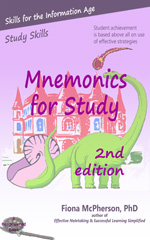The story method (sometimes called the sentence mnemonic) is the most easily learned list-mnemonic strategy, although it is not as widely known as the other simple methods we’ve talked about so far.
As its name suggests, the story method involves linking words to be learned in a story. While this is most obviously useful for learning actual lists, it can also be used for remembering the main points of a passage. In such a case, you need to reduce each point to a single word, which hopefully has the power to recall the whole point.
Let’s look at an example. First, an easy one — a list:
Vegetable Instrument College Carrot Nail Fence Basin Merchant Scale Goat
This can be transformed into:
A VEGETABLE can be a useful INSTRUMENT for a COLLEGE student. A CARROT can be a NAIL for your FENCE or BASIN. But a MERCHANT would SCALE that fence and feed the carrot to a GOAT.
But let’s face it , this is not a very probable list of words for you to memorize. The example is taken (with some modification) from a laboratory experiment1, and the few tests of the story mnemonic that there have been have tended to involve such lists of unrelated words. But learning lists of unrelated words is not something we need to do very often. And generally, if we do have lists of words to learn — say, the names of the elements in the periodic table — they’re going to be too technical to lend themselves readily to creating a story.
Even if the words themselves are not particularly technical, the nature of them is not likely to lend itself to a narrative. Let me show you what I mean. Consider the taxonomy of living things:
Kingdom
Phylum
Class
Order
Family
Genus
Species
Here’s an attempt at a story:
In the KINGDOM, PHYLUM is a matter of CLASS, but ORDER is a matter for FAMILY, and GENIUS lies in SPECIES.
The trouble with this is not the re-coding of genus to genius; the trouble is, it doesn’t make a lot of sense. It’s a sentence, but not a story — there’s no narrative. Humans think in stories. We find them easy to remember because they fit in with how we think. It follows then that the more effective story mnemonics will actually tell a story. To do that, we’re going to have to transform our technical words into more common words.
King Phillip went to the classroom to order the family genius to specifically name the individual who had stolen the taxi.
The last part of this is of course unnecessary — you could finish it after individual if you wished. But an important thing to remember is that it’s not about brevity. It’s about memorability. And memorability is not as much affected by amount to remember, as it is by the details of what is being remembered. So meaningfulness is really important. Adding that little detail about stealing the taxi adds meaningfulness (and also underlines what this mnemonic is about: taxonomy).
Here’s a longer example. Remember our hard-to-remember cranial nerves? This story was mentioned in a 1973 Psychology Today article by the eminent psychologist G.H. Bower2:
At the oil factory the optician looked for the occupant of the truck. He was searching because three gems had been abducted by a man who was hiding his face and ears. A glossy photograph had been taken of him, but it was too vague to use. He appeared to be spineless and hypocritical.
Here it is again with the nerves shown for comparison:
At the oil factory (olfactory) the optician (optic) looked for the occupant (oculomotor) of the truck (trochlear). He was searching because three gems (trigeminal) had been abducted (abducens) by a man who was hiding his face (facial) and ears (auditory). A glossy photograph (glossopharyngeal) had been taken of him, but it was too vague (vagus) to use. He appeared to be spineless (spinal accessory) and hypocritical (hypoglossal).
Notice how, with these technical words, they have been transformed into more familiar words — this is what I meant by saying the keyword method is a vital part of all these list-mnemonics.
Excerpted from Mnemonics for Study
